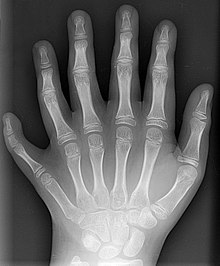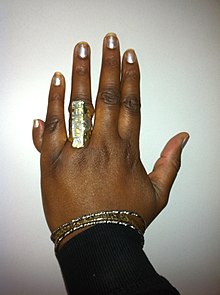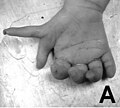Polydactyly: Difference between revisions
ClueBot NG (talk | contribs) m Reverting possible vandalism by 77.250.38.115 to version by Luckas-bot. False positive? Report it. Thanks, ClueBot NG. (380075) (Bot) |
Luca Di-Maio (talk | contribs) |
||
| Line 79: | Line 79: | ||
* [[Antonio Alfonseca]], a [[Major League Baseball]] [[pitcher]]. |
* [[Antonio Alfonseca]], a [[Major League Baseball]] [[pitcher]]. |
||
* [[Gemma Arterton]],<ref name="IMDb1">{{Cite web|title=Arterton's Extra Digits|publisher=IMDb|date=7 October 2008|url=http://www.imdb.com/news/ni0579273|accessdate=9 February 2010}}</ref><ref>{{Cite news|publisher=Advance Publications|title=Personality Parade - David Letterman|newspaper=Parade|date=10 November 2009|url=http://www.parade.com/celebrity/2009/10/personality-parade-david-letterman.html}}</ref> actress. |
* [[Gemma Arterton]],<ref name="IMDb1">{{Cite web|title=Arterton's Extra Digits|publisher=IMDb|date=7 October 2008|url=http://www.imdb.com/news/ni0579273|accessdate=9 February 2010}}</ref><ref>{{Cite news|publisher=Advance Publications|title=Personality Parade - David Letterman|newspaper=Parade|date=10 November 2009|url=http://www.parade.com/celebrity/2009/10/personality-parade-david-letterman.html}}</ref> actress. |
||
* [[Rebecca Black]],[[Singer]], born with 6 toes on each foot, 2 being webbed together on the left. |
|||
* [[Reggae]] artist [[Jimmy Cliff]], born with ulnar polydactyly on both hands (removed shortly after birth). |
* [[Reggae]] artist [[Jimmy Cliff]], born with ulnar polydactyly on both hands (removed shortly after birth). |
||
* [[Hampton Hawes]], [[jazz]] [[pianist]], was born with six fingers on each hand (surgically removed shortly after birth).<ref>{{Cite web|last=Harrison|first=Dennis|title=Hamptom Hawes And The Fire Inside|work=|publisher=JazzScript|date=|url=http://www.jazzscript.co.uk/extra/art.hawes.htm|accessdate=9 February 2010}}</ref> |
* [[Hampton Hawes]], [[jazz]] [[pianist]], was born with six fingers on each hand (surgically removed shortly after birth).<ref>{{Cite web|last=Harrison|first=Dennis|title=Hamptom Hawes And The Fire Inside|work=|publisher=JazzScript|date=|url=http://www.jazzscript.co.uk/extra/art.hawes.htm|accessdate=9 February 2010}}</ref> |
||
Revision as of 22:41, 13 April 2011
This article needs additional citations for verification. (June 2008) |
| Polydactyly | |
|---|---|
| Specialty | Medical genetics |
Polydactyly or polydactylism (from Ancient Greek πολύς (polus) "many" + δάκτυλος (daktulos) "finger"), also known as hyperdactyly, is a congenital physical anomaly in humans, dogs, and cats having supernumerary fingers or toes.[1]
Presentation


The extra digit is usually a small piece of soft tissue that can be removed. Occasionally it contains bone without joints; rarely it may be a complete, functioning digit. The extra digit is most common on the ulnar (little finger) side of the hand, less common on the radial (thumb) side, and very rarely within the middle three digits. These are respectively known as postaxial (little finger), preaxial (thumb), and central (ring, middle, index fingers) polydactyly. The extra digit is most commonly an abnormal fork in an existing digit, or it may rarely originate at the wrist as a normal digit does.[2]
Genetics
Polydactyly can occur by itself, or more commonly, as one feature of a syndrome of congenital anomalies. When it occurs by itself, it is associated with autosomal dominant mutations in single genes, i.e. it is not a multifactorial trait.[3] But mutation in a variety of genes can give rise to polydactyly. Typically the mutated gene is involved in developmental patterning, and a syndrome of congenital anomalies results, of which polydactyly is one feature or two.
Types include:
| OMIM | Type | Locus |
|---|---|---|
| Template:OMIM2 | Postaxial A1 | GLI3 at 7p13 |
| Template:OMIM2 | Postaxial A2 | 13q21-q32 |
| Template:OMIM2 | Postaxial A3 | 19p13.2-p13.1 |
| Template:OMIM2 | Postaxial A4 | 7q22 |
| Template:OMIM2 | Preaxial I | ? |
| Template:OMIM2 | Preaxial II | SHH at 7q36 |
| Template:OMIM2 | Preaxial III | ? |
| Template:OMIM2 | Preaxial IV | GLI3 at 7p13 |
Syndromes including polydactyly include Acrocallosal syndrome, Basal cell nevus syndrome, Bardet-Biedl syndrome, Biemond syndrome, Ectrodactyly-ectodermal dysplasias-cleft lip/palate syndrome, Ellis van Creveld syndrome, Meckel Gruber syndrome, McKusick-Kaufman syndrome, Mirror hand deformity, Mohr syndrome, Oral-facial-digital syndrome, Pallister-Hall syndrome, Rubinstein-Taybi syndrome, Short rib polydactyly, and VATER association.[4] It can also occur with a triphalangeal thumb.
Epidemiology

The condition has an incidence of 1 in every 500 live births.[5] Postaxial hand polydactyly is a common isolated disorder in African black and African American children, and autosomal dominant transmission is suspected. Postaxial polydactyly is approximately 10 times more frequent in blacks than in whites and is more frequent in male children.[6] In contrast, postaxial polydactyly seen in white children is usually syndromic and associated with an autosomal recessive transmission. One study by Finley et al. combined data from Jefferson County, Alabama, United States and Uppsala County, Sweden. This study showed incidence of all types of polydactyly to be 2.3 per 1000 in white males, 0.6 per 1000 in white females, 13.5 per 1000 in black males, and 11.1 per 1000 in black females.[7]
Society and culture
People affected
- Anahí, Mexican actress and singer.
- Antonio Alfonseca, a Major League Baseball pitcher.
- Gemma Arterton,[8][9] actress.
- Rebecca Black,Singer, born with 6 toes on each foot, 2 being webbed together on the left.
- Reggae artist Jimmy Cliff, born with ulnar polydactyly on both hands (removed shortly after birth).
- Hampton Hawes, jazz pianist, was born with six fingers on each hand (surgically removed shortly after birth).[10]
- Toyotomi Hideyoshi, Japanese daimyo who unified Japan in the Sengoku period.
- Kamani Hubbard, a boy born with a rare case of polydactyly with both 12 fully functioning fingers and 12 toes.[11]
- Varalakshmi V, a girl born with a rare case of polydactyly with 27 fingers and toes. She is from Bangalore and has eight fingers in each hand and about four to five extra toes in each foot.[12]
- Liam Gallagher, lead vocalist of defunct British rock band Oasis, has six toes on his left foot.
- Little Tich, an English music hall comedian.
- Hrithik Roshan, a Bollywood actor born with a supernumerary thumb on his right hand.[13]
- A Philistine Giant of the city of Gath and brother of Goliath the champion, a descendant of the sons of Rapha. "He was a man of great stature, that had on every hand six fingers, and on every foot six toes, four and twenty in number."[14]
- Roman era poet Volcatius Sedigitus.
- Garfield Sobers, West Indian cricketer, had an extra finger on each hand which he removed himself during childhood "with the aid of catgut and a sharp knife".[15]
- Blues guitarist Hound Dog Taylor
- Phil Thompson, retired English professional footballer, was born with 12 toes and is said to have regularly won wagers by conning people to bet upon who has the most toes. "Let's put our toes on the table and whoever has the most collects the cash. I'll even give you the draw" is recounted time and time again in 1980s footballers memoirs.
- Sid Wilson, turntablist of Slipknot. He was born with an extra digit on his hands and feet. They were dead, however, and were removed shortly after birth.
- Henry II the Pious, King of Poland during the first Mongol invasion. Decapitated, he was only identified by his wife due to having six toes on his left foot.
Fiction
- Marilyn Manson, an American singer, had portrayed an alien on his Mechanical Animals album, and on the cover he was shown with a sixth finger on his left hand.
- Dr. Hannibal Lecter genius cannibalistic psychiatrist and serial killer in series of Thomas Harris novels, including The Silence of the Lambs.
- Count Tyrone Rugen, murderous henchman of Prince Humperdink in the novel The Princess Bride by William Goldman and in the film based on that book directed by Rob Reiner, had six fingers on his right hand.
- Frank Nunn, hired killer of Trudy Monk in the television series Monk.
- Alonzo the Armless, a circus performer from the silent film The Unknown.
- The 1997 science fiction film Gattaca had a fictional twelve fingered pianist, who played a modified version of a Schubert impromptu. It was mentioned that the modified work could only be played by a pianist with twelve fingers.
- Dimitri Borja Korosec, the clumsy trained killer who stars the Brazilian novel Twelve Fingers: Biography of an Anarchist (original: O Homem Que Matou Getúlio Vargas), by Jô Soares.
- Ushiromiya Kinzo, a wealthy but elderly businessman and black magician in the visual novel Umineko no Naku Koro ni, as well as the manga and anime based on the novel.
- Little Ozzie, in the novel Odd Thomas by Dean Koontz, is a morbidly obese, extremely successful mystery novelist, with six fingers on his left hand.
- In the X-Files episode "All Souls", Agents Mulder and Scully attempt to solve the case of two murdered polydactyl girls.
- The Comyn, in the Darkover science fiction novels by Marion Zimmer Bradley, often have six-fingered hands.
- Sophie Wender in the novel The Chrysalids by John Wyndham is born with six toes.
- The cover of the Jethro Tull 1969 album Stand Up depicts (in its woodcut style drawing of the band) singer/flutist Ian Anderson with six fingers on his left hand
- The cover of The Pogues 1989 album, Peace and Love depicts a boxer with six fingers on his right hand
- In the Inheritance series by Christopher Paolini, Dwarves and urgals have seven digits on each foot.
Other animals
Cats normally have five digits on the front paws and four on the rear. Polydactyl cats have more, and this is a moderately common condition, especially in certain cat populations.
Polydactyly is a common trait in several heritage chicken breeds, including silkies.
A number of mutations of the LMBR1 gene, in dogs, humans, and mice, can cause polydactyly.[16] Dogs, like other canids, normally have four claws on their rear paws; a fifth is often called a dewclaw and is especially found in certain dog breeds,[16] including the Norwegian Lundehund and Great Pyrenees.
Polydactyly was common in the earliest tetrapods, the number of digits settling to the common five on each foot in amniotes and four to the hand and five to the foot in amphibians in the early Carboniferous, see Polydactyly in early tetrapods
Additional images
-
Preaxial polydactyly.
-
Postaxial polydactyly.
-
Preaxial polydactyly.
References
- ^ Kaneshiro, N. (2009, November 2). Polydactyly. Retrieved December 4, 2010, http://www.umm.edu/ency/article/003176.htm
- ^ Eaton, Charles. "Polydactyly (Extra Fingers)". Retrieved 9 February 2010.
- ^ "Polydactyly and Syndactyly". Milton S. Hershey Medical Center. Retrieved 9 February 2010.
- ^ "Supernumerary Digit: Differential Diagnoses & Workup - eMedicine Dermatology". Retrieved 2010-05-15.
- ^ Greene, Alan (30 July 2008). "Polydactylism". Dr. Greene. Retrieved 9 February 2010.
{{cite web}}: Unknown parameter|coauthors=ignored (|author=suggested) (help) - ^ Kaneshiro, Neil K. (11 February 2009). "Polydactyly". Penn Medicine. Retrieved 9 February 2010.
{{cite web}}: Unknown parameter|coauthors=ignored (|author=suggested) (help) - ^ Carter G, Abel (31 July 2008). "Supernumerary Digit". eMedicine. Retrieved 9 February 2010.
{{cite web}}: Unknown parameter|coauthors=ignored (|author=suggested) (help) - ^ "Arterton's Extra Digits". IMDb. 7 October 2008. Retrieved 9 February 2010.
- ^ "Personality Parade - David Letterman". Parade. Advance Publications. 10 November 2009.
- ^ Harrison, Dennis. "Hamptom Hawes And The Fire Inside". JazzScript. Retrieved 9 February 2010.
- ^ Baby Born In Bay Area With 12 Functioning Fingers, 12 Toes
- ^ [1]
- ^ "a star is born: HRITHIK ROSHAN". BollyVista. Retrieved 9 February 2010.
- ^ II Samuel Chapter 21 & verse 20. Authorized King James Version of the Bible.
- ^ Sobers, Garfield (1 May 2002). Garry Sobers: My Autobiography. Headline Book Publishing. p. 6. ISBN 978-0755310067.
- ^ a b Park, K; Kang, J; Subedi, Kp; Ha, Jh; Park, C (2008). "Canine polydactyl mutations with heterogeneous origin in the conserved intronic sequence of LMBR1" (Free full text). Genetics. 179 (4): 2163–72. doi:10.1534/genetics.108.087114. ISSN 0016-6731. PMC 2516088. PMID 18689889.
{{cite journal}}: Unknown parameter|month=ignored (help)CS1 maint: multiple names: authors list (link)



